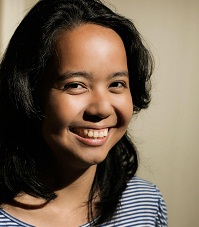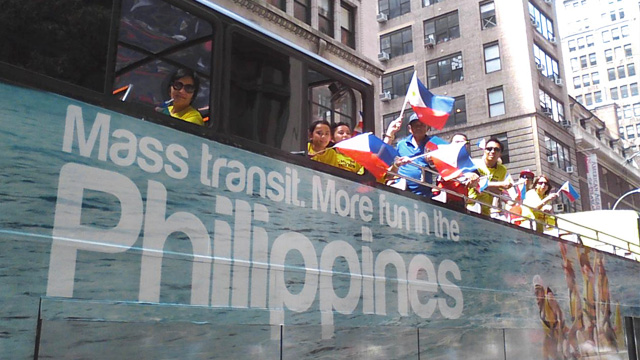SUMMARY
This is AI generated summarization, which may have errors. For context, always refer to the full article.

I once wrote an article decrying the apparent mainstream invisibility of Filipino culture in New York City. But recently, I was proven wrong by my fellow New Yorker kababayans, who all brought their immense energy and chutzpah as they stomped down Madison Avenue in a colorful array of traditional Filipino costumes, songs and dances celebrating our shared culture and heritage.
Two weeks ago, the 2013 Philippine Independence Day Parade and Cultural Festival spotlighted the best of Filipino culture, history and food along Madison Avenue, set at the heart of the global, cosmopolitan stage of New York City.
Each year, the celebration comes well in advance of June 12, the proverbial day of our independence, but it almost seemed to serve as a festive herald. The program featured a two-hour long parade of Filipino groups from all over the Tri-State Area, and a bustling street fair bursting with Filipino food, music and chatter.
My involvement in the parade and festival was completely fortuitous. As luck would have it, my previous article on Filipino invisibility had attracted the attention of a certain skeptical reader who happened to coordinate public relations for the parade.
Determined to make me reconsider my extreme views, she contacted me directly to ask if I would volunteer my “youthful energy” to promotional efforts for the parade, especially in social media. Intrigued, I agreed to her request.
Not only did I wish to expand my amateur professional repertoire, but more importantly, I wanted to see firsthand how my fellow Pinoy kababayans here in New York would showcase Filipino culture through a parade on New York’s global stage. I had already enjoyed the street fair back in the summer of 2011, but this time, I looked forward to witnessing the actual parade this year.
In stark contrast to the half-baked cynicism in my first article, this time I wanted to be proven wrong. Deep in my heart, I knew the only reason I had pretended such affect was because I didn’t want to believe we Filipinos were an invisible minority in New York City. It was a plea, a veiled cry for recognition for the thousands of faceless Pinoy nurses, doctors, medical workers, busboys, admin staff and corporate drones all hustling to live out their respective American Dreams in the Big Apple – we are here, too, and we’d like you to pay attention to us.
I was not disappointed.
Pinoy pride
The sheer kaleidoscopic combination of rhythms, colors and movements that I heard and saw on Madison Avenue made me ashamed to have entertained even the slightest shed of doubt. Filipino culture in New York was very much alive here: it was pumping, joyous and stunningly multifaceted.
The parade showcased rich and vivid cultural representations from almost all corners of the Philippines – the regal, graceful Maranao from the southern isles of Mindanao, the proud Igorots from the northern Cordillera mountains, the Dinagyang dancers infused with the frenetic energy of central Iloilo.


It looked like almost all the Filipino tribes and traditions from my Grade 5 Hekasi/Sibika (Social Studies) book suddenly came to life and started strutting on Madison Avenue.
There were contemporary Filipino groups from all sectors of society that marched too – photographers, bankers, accountants, activists, senior citizens, religious folk, beauty queens – you name it, they all waved the venerable Filipino flag.
I was taken aback, but relished the unabashed outpouring of Filipino pride and gusto that unfolded before me. Nothing could have prepared me for these spectacles. Soon enough, I began to dutifully eat my humble pie, swallowing down morsels of my premature cynicism towards Filipino invisibility in New York City.
Street fair
The parade might have been a feast for my eyes, but the subsequent street fair was a banquet for all my other senses.
A pungent, delectable smell of Pinoy BBQ being turned over glowing hot coals pervaded the air around and above Madison Square Park. The afternoon sun made certain, arbitrary details around me glisten with startling clarity – the sago balls swimming in black gulaman sauce, the countless, colorful varieties of cooked food, the sweat on people’s smiling, brown faces. It smelled like bungang singot everywhere I turned, because I was surrounded by a crush of human beings from all sides.
The street fair was chaotic, crowded and completely disorganized – I thought to myself, in true palengke style. But it was undoubtedly Pinoy through and through. Right down to showbiz stars who were imported straight from the Philippines, like Gary V, Marian Rivera and the Megastar, who all performed before a throng of diehard Fil-Am fans.
It was unpretentious. It was haphazard. It was maybe even a bit – dare I say it? – “masa.” But most of all, it was true to itself.
All the intense sights, smells, colors and chatter at the street fair suddenly transported me back home to a Philippines that had left its indelible mark upon my soul and memory. A country of hope that manages to face the utter chaos and despair of day-to-day survival head-on, with a God-fearing prayer and a cheerful grin. A people of never-ending toil and perseverance yet still taking pleasure in the small things in life, no matter how “gauche” or “masa” they may be.
The street fair was not the best representation of Pinoy culture necessarily, but I felt it was certainly one of the truest.

One community
As the parade and street fair unraveled in all its glory throughout the avenue, I couldn’t help but think: is this the only day that Filipinos in New York can come together as one, single, united community? The turnout that day was spectacular. Now if only we could just sustain and build upon that sense of community for longer than just one day.
But as a newfound Filipino friend put it: “We’re too spread out, too busy, and assimilate quite nicely so it’s hard to see it on a daily basis. But we’re here, we’re strong, and most that I’ve met love the Philippines dearly (though in different ways).”

I may be remiss in thinking that Filipinos in New York have to unite as a community in order to be noticed by mainstream America. Perhaps public recognition isn’t even a coveted social ideal they aspire for in the first place. Maybe it’s simply enough for them to love their traditions, their culture and their history, in their own small and meaningful ways.
Maybe it’s simply enough to be Pinoy, without having to shout it to the world. And maybe, just maybe, when we stop trying to prove ourselves, the rest of the world will take notice. – Rappler.com
Originally from Quezon City, Manila, Maki Somosot is now based in Brooklyn, New York. She currently works in a public relations agency.
Add a comment
How does this make you feel?
There are no comments yet. Add your comment to start the conversation.